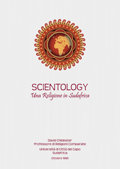1. Church of Scientology, A Description of the Scientology Religion (Los Angeles: Chiesa di Scientology Internazionale, 1993): 2.
2. E. B. Tylor, Primitive Culture, 2 volumi. (Londra, John Murray, 1920): I:424; Emile Durkheim, The Elementary Forms of the Religious Life, traduzione Joseph Ward Swain (New York: The Free Press, 1965): 62. Un’utile “mappa” multi-dimensionale per lo studio della religione è stata sviluppata da Ninian Smart in alcune pubblicazioni, tra le quali The Religious Experience of Mankind (Glasgow: Collins, 1971); The Science of Religion and the Sociology of Knowledge (Princeton: Princeton University Press, 1973); The Phenomenon of Religion (London: Macmillan, 1973); Worldviews: Crosscultural Explorations of Human Beliefs (New York: Charles Scribners, 1983). Per un’ulteriore analisi della definizione di religione, vedere David Chidester, Gordon Mitchell, Isabel Apawo Phiri e A. Rashied Omar, Religion in Public Education: Options for a New South Africa, 2ª edizione. (Città del Capo, UCT Press, 1994).
3. Emile Benveniste, Indo-European Language and Society (traduzione) Elizabeth Palmer (London: Faber and Faber, 1973; edizione originale 1969): 522.
4. J. T. van der Kemp, “An Account of the Religion, Customs, Population, Government, Language, History, and Natural Productions of Caffraria,” Transazioni della Società Missionaria, (londinese) Vol. 1 (Londra: Bye & Law, 1804): 432.
5. W. M. Eiselen, “Geloofsvorme van Donker Afrika,” Tydskrif vir Wetenskap en Kuns 3 (1924/25): 84.
6. Peter Harrison, ‘Religion’ and the Religions in the English Enlightenment (Cambridge: Cambridge University Press, 1990): 39.
7. David A. Pailin, Attitudes to Other Religions: Comparative Religion in Seventeenth and Eighteenth-Century Britain(Manchester: Manchester University Press, 1984).
8. F. Max Müller, Introduction to the Science of Religion (Londra: Trübners, 1873).
9. Oltre alle opere di Harrison e Pailin sopraccitate, anche le descrizioni recenti dell’apparizione storica dei termini moderni di “religione” e “religioni” sono state date da Peter Byrne, Natural Religion and the Nature of Religion: The Legacy of Deism (London: Routledge, 1989); J. Samuel Preus, Explaining Religion: Criticism and Theory from Bodin to Freud (New Haven: Yale University Press, 1987); Eric J. Sharpe, Comparative Religion: A History, 2ª edizione (La Salle, Illinois: Open Court, 1986); e Michel Despland e Gerard Vallée (curatori) Religion in History: The Word, the Idea, the Reality (Waterloo, Ont.: Wilfrid Laurier University Press, 1992). Per una ricerca approfondita, vedere Wilfred Cantwell Smith, The Meaning and End of Religion (New York: Macmillan, 1962): Michel Despland, La religion en Occident: Evolution des idées et du vécu (Montreal: Fides, 1979); and Ernst Feil, Religion: Die Geschichte eines neuzeitlichen Grundbegriffs vom Frühchristentum bis zur Reformation (Göttingen: Vandenhoeck and Ruprecht, 1986). Per un’analisi della produzione storica dei termini “religione” e “religioni” nell’Africa meridionale, vedere David Chidester, Savage Systems: Colonialism, Religion, and Comparative Religion in Southern Africa (Charlottesville: University Press of Virginia, disponibile dal 1996).
10. Circa il movimento anti-setta, vedere David Bromley e Anson D.Shupe, The New Vigilantes: Deprogrammers, Anti-Cultists, and the New Religions (Beverly Hills, California: Sage, 1980). Nelle analisi accademiche, possono riapparire dichiarazioni anti-setta in modelli teorici che dipingono le nuove religioni come forme di psicopatologia, attività imprenditoriale o devianza sociale. Vedi William Sims Bainbridge e Rodney Stark, “Cult Formation: Three Compatible Models,” di Jeffrey K.Hadden e Theodore E.Long, eds., Religion and Religiosity in America (New York: Crossroad, 1983): 35–53.
11. G. P. C. Kotzé e altri, Report of the Commission of Inquiry into Scientology for 1972 (Pretoria: Government Printer, 1973): 208.
12. G. C. Oosthuizen, The Church of Scientology: Religious Philosophy, Religion, and Church (Johannesburg: Chiesa di Scientology, 1975): 11.
13. L. Ron Hubbard, La Creazione della Capacità Umana: Un Manuale per gli Scientologist, 351.
14. Per un esempio di questo approccio, vedere Hendrik Kraemer, The Christian Message in a Non-Christian World(Londra: Edinburgh House Press, 1938).
15. L. Ron Hubbard, Conferenze di Phoenix (Edimburgo: Organizzazione Mondiale delle Pubblicazioni, 1968): 35.
16. Ibidem, 13.
17. Ibidem, 11.
18. L. Ron Hubbard, Scienza della Sopravvivenza: Previsione del Comportamento Umano, 488.
19. L. Ron Hubbard, Scientology 0-8: Il Libro dei Fondamenti,410.
20. L. Ron Hubbard, Scientology 8-8008,121.
21. Hubbard, Cerimonie della Chiesa Fondatrice di Scientology, 7.
22. Jonathan Z.Smith, “Healing Cults,” New Encyclopaedia Britannica, Macropaedia, vol. 8 (Chicago, 1977): 685.
23. Henry Clarke Warren, traduzione, Buddhism in Translations (New York: Atheneum, 1979): 405.
24. Morton Bloomfield, The Seven Deadly Sins: An Introduction to the History of a Religious Concept (East Lansing: Michigan State University Press, 1967).
25. Riguardo alle discordanze e all’armonia nell’etica religiosa, vedi David Chidester, Patterns of Action: Religion and Ethics in a Comparative Perspective (Belmont, Calif.: Wadsworth, 1987): 67–105.
26. Hubbard, Scienza della Sopravvivenza, 46.
27. Mircea Eliade, Shamanism: Archaic Techniques of Ecstasy, traduzione Willard R.Trask (Princeton: Princeton University Press, 1964).
28. Felicitas Goodman, Ecstasy, Ritual, and Alternative Reality: Religion in a Pluralistic World (Bloomington: Indiana University Press, 1988); Where the Spirits Ride the Wind: Trance journeys and other Ecstatic Experiences (Bloomington: Indiana University Press, 1990).
29. Per un’analisi che ha screditato le dichiarazioni che le nuove religioni siano impegnate nel lavaggio del cervello, vedere David Bromley e James Richardson, curatori, The Brainwashing/Deprogramming Controversy: Sociological, Psychological, Legal, and Historical Perspectives (New York: Edwin Mellen Press, 1983); e Dick Anthony, “Religious Movements and Brainwashing Litigation: Evaluating Key Testimony” di Thomas Robbins e Dick Anthony, curatori, In Gods We Trust: New Patterns of Religious Pluralism in America, 2ª edizione. (New Brunswick, New Jersey: traduzione, 1990): 295–325.
30. Chiesa di Scientology, What Is Scientology?: The Comprehensive Reference on the World’s Fastest Growing Religion (Los Angeles: Bridge Publications): 245.
31. Ibidem, 274.
32. Church of Scientology, Description of the Scientology Religion, 8.
33. David Chidester, Patterns of Power: Religion and Politics in American Culture (Englewood Cliffs, New Jersey: Prentice Hall, 1988): 239–41.
34. Kotzé, Rapporto della Commissione d’Inchiesta, 209.
35. Chiesa di Scientology, Risposta al Rapporto della Commissione d’Inchiesta: “Il Rapporto Mancante”, per Conoscenza ai Membri del Parlamento (Johannesburg: Chiesa di Scientology, 1973): 41.
36. Citato nell’Ibidem, 43.
37. Chiesa di Scientology, Che Cos’è Scientology, 527.
38. Chiesa di Scientology, Libro di Consultazione alla Religione di Scientology: Risposte alle Domande Poste Più Comunemente dai Media (Los Angeles: Chiesa di Scientology Internazionale, 1994): 22.
39. Citizens Commission on Human Rights, “Psichiatria e Sudafrica”, Creare il Razzismo: Il Tradimento della Psichiatria Sotto Forma di Aiuto (Los Angeles, CCHR, 1995): 18.
40. Klippies Kritzinger, ed., Believers in the Future (Città del Capo: World Conference on Religion and Peace, South African Chapter, 1991).
41. William James, The Varieties of Religious Experience (New York: Macmillan, 1961): 393.
42. Roy Wallis, “Hostages to Fortune: Thoughts on the Future of Scientology and the Children of God”, di David G. Bromley and Phillip E. Hammond, eds., The Future of New Religious Movements (Macon, Georgia: Mercer University Press, 1987): 80–84; Robert Ellwood, “A Historian of Religion Looks at the Future of New Religious Movements,” nell’ ibidem, 249–50; Benton Johnson, “A Sociologist of Religion Looks at the Future of New Religious Movements”, nell’ ibidem, 253–56.





























